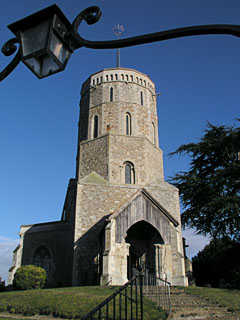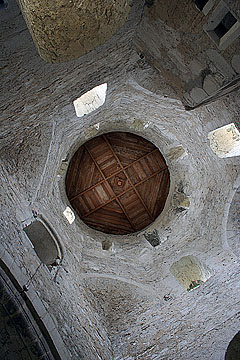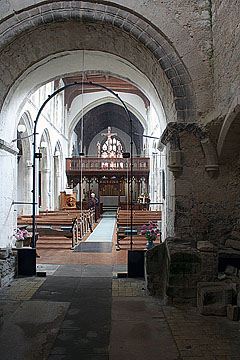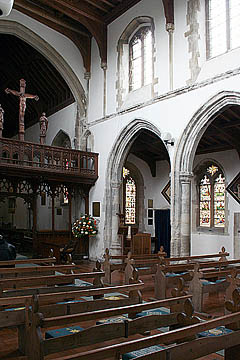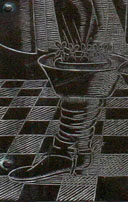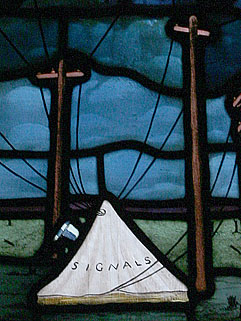Swaffham Prior is famous amongst Cambridgeshire villages for having two churches in the same churchyard. The effect is quite dramatic: a grass slope punctuated with cedar trees rises steeply away from the main street, and crowning it sit the two churches of St Mary the Virgin and SS Cyriac and Julitta.
Why, one might ask, are there two churches here? The reason seems to be that, unusually, there were two manors in the village of Swaffham Prior. The first churches in a settlement were often built by the lord of the manor to provide for their vassals; for the most part, since villages tended to develop under the aegis of just one manor, one would end up with just one church in each settlement. There are exceptions, though.
Elsewhere in Cambridgeshire, the village of Duxford has two churches, dedicated to St Peter and to St John, for the same reason; and there used to be a second church in Burwell. It’s very unusual to have both churches sitting within the same churchyard, though. Evidently the two manors – owned by the Abbey of Ely and some knightly vassals of Count Alan of Brittany respectively – must have got on quite well.
The two churches served completely separate parishes, despite the fact that the population of Swaffham Prior was never more than a couple of hundred people. The parishes remained distinct until the beginning of the 19 th century, as it happens; but they ceased functioning as separate entities in 1667, when an Act of Parliament united the two vicarages, to be occupied by a single priest. At that point, the two congregations combined, and adopted St Mary as their place of worship.
The situation remained thus, with St Cyriac gradually falling into disrepair, until in 1779 the tower of St Mary was struck by lightning. This caused a lot of damage – a fireball is reported to have fallen into the nave – and the nave and porch were further damaged by falling masonry in 1802 when the top of the tower was being demolished. At that point, the congregation shifted to St Cyriac, and it was St Mary’s turn to be left to decay for a hundred years. Then, for some reason, it was decided to rebuild St Mary’s, and between the Octobers of 1901 and 1902 there was a great restoration that restored it to active service. Now, St Cyriac is once again empty and redundant, and St Mary is the parish church.
As you might expect from such a turbulent history, this is a battered building. Most of that is hidden from first glance, though. The western tower is a splendid thing, having had its top levels restored in the mid-20 th century. It rises from a massive square base to an octagonal Norman middle stage, with round-headed windows in the cardinal directions. Above that, there is an Early English sixteen-sided stage, pierced frequently with elegant little lancets, and the whole thing is topped off by a restored blind arcade. The top of the tower is without battlements, but there is a modern fibreglass spike piercing a crown which catches the sun spectacularly. It’s a fine sight – Pevsner is a bit sniffy (saying that the jagged ruined top looked perfectly OK), but I think it looks rather good.
If you lower your eyes from the dazzling spire, though, St Mary’s wounds start to become visible. There is a porch on the west face of the tower, and it was once a fully stone structure, complete with a vault. The top half, though, was destroyed in the 1802 disaster, and has been replaced with a modest wooden structure sitting on top of the jagged stone walls. Within the tower space, the 13 th century vault which originally provided a ceiling to the ground floor has been lost, and the tower is now open to the top. I rather like the effect of this, though; the window openings further up the tower are very rough, and the space is excitingly cavernous. It is separated from the nave by a large Norman tower arch, which is now filled with a glass partition.
Inside, the Perpendicular nave arcades are impressively weathered, bearing witness to a hundred years in which they were open to the elements. Almost the whole of the rest of the building dates from the 1901 restoration, although there are reused bits and bobs. The old rood stair still sits in the south aisle, for example, and I think that the corbels supporting the nave roof are original; they are in the form of small pillars with battlemented capitals, and sit on a course of tiny battlements running between the clerestory windows and the nave arcades. Within the chancel walls are two large round-headed windows which looked ancient to me, and there is a deep squint running between the chancel and the north aisle.
Poking around, we did find a few curiosities. There are several brasses set into the walls of the aisles: in the north aisle, there are small figures commemorating Richard Wates (d. 1515) and William Wates (d.1521) along with their families. In the south aisle is one that commemorates one John Tothyll and his wife, the former wearing splendid spiky armour. Their brass seems to be reused, though, since below there is an inscription commemorating someone called Duery, who came from the nearby hamlet of Reach. Below them is the best brass of all: a 17th century memorial to Robert Chalmers which is engraved with a portrait of him standing on a chequered floor in huge boots and a Carolingian beard. He died in 1638, just in time to avoid the Civil War.
These curiosities aside, St Mary is a rather sad, dark church. Two of the windows in the north aisle are interesting: they serve as memorials to the two World Wars, and depict zeppelins, aircraft, soldiers and women working in munitions factories. The restorers filled the rest of the windows with dark, unexciting glass, though; and the whole church has a rather sombre air. Despite the fact that St Cyriac is now redundant and St Mary has survived in use as a parish church, the years weigh far more heavily on the latter.
St Mary the Virgin is kept open.
